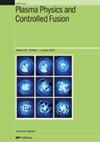在 JET 托卡马克中测量 He II 线强度
IF 2.3
2区 物理与天体物理
Q2 PHYSICS, FLUIDS & PLASMAS
引用次数: 0
摘要
了解托卡马克放电中使用的 D 或 He 燃料的行为对于模拟边缘和分流器传输以及容器壁侵蚀等分析至关重要。然而,在 JET 托卡马克上进行的测量与用于预测类氢 D 和 He 线强度的碰撞辐射模型之间的一致性很差。发射辐射的等离子体的温度范围也很有限,而许多杂质的温度范围则很宽。对于 He II 来说尤其如此,在大多数脉冲中,其线强度往往具有相同的近乎恒定的比率,这表明辐射源自电子温度非常相似的等离子体区域。为了加深了解并与理论模型进行定量比较,我们在三次 He 活动期间对所有放电方案的紫外-紫外莱曼系列进行了广泛观测。本文介绍了在 JET ITER-like wall (JET-ILW) 和 JET C (JET-C) 活动中对氦放电进行的观测。与使用 D 作为燃料时相比,He 放电的优点是杂质较少,因此光谱不那么复杂。不过,这两种物质的观测差异特征相似,因此可以用 He 代替 D 来了解差异。此外,对 He 的研究避免了分子物种对水平种群的影响这一复杂问题。氦气排放的不透明效应预计也不会太严重。尽管如此,为了确保测量结果不会受到不透明度的过度影响,我们还与巴尔默和帕申系列成员的发射进行了比较。对所有脉冲勘测和单个脉冲的线强度及其比值都进行了测量。在 He 发射强度较高的特殊情况下,He II 线强度与之相关。说明了这些测量结果与理论模型之间的差异。本文章由计算机程序翻译,如有差异,请以英文原文为准。
He II line intensity measurements in the JET tokamak
An understanding of the behaviour of the D or He fuel used in tokamak discharges is essential in analyses such as modelling edge and divertor transport and the erosion of the vessel walls. However, poor agreement is found between measurements made on the JET tokamak and collisional-radiative models used to predict the hydrogen-like D and He line intensities. The range of temperatures of the plasmas emitting the radiation is also limited, in contrast to that for many impurities for which a wide range is possible. This is particularly so for He II whose line intensities tend to have the same near-constant ratios in most pulses, suggesting that the emission originates in plasma regions with very similar electron temperatures. To gain understanding and to allow quantitative comparisons with theoretical models, extensive observations of the VUV Lyman series have been made, for all discharge scenarios run during three He campaigns. Those for He discharges in both JET ITER-like wall (JET-ILW) and JET C (JET-C) campaigns are presented here. He discharges have the advantage of fewer impurities resulting in less complex spectra than when D is used as the fuel. However, the characteristics of the observed discrepancies are similar in both species, allowing He to be used as a proxy for D in order to gain understanding of the discrepancy. In addition, the study of He avoids the complication of molecular species contributing to the level populations. Opacity effects are also expected to be less severe in He discharges. Nevertheless, so as to ensure that the measurements are not unduly affected by opacity, comparisons have also been made with emission from Balmer and Paschen series members. Measurements of both line intensities and their ratios are presented for all-pulse surveys and for individual pulses. In exceptional cases in which the He emission is intense a dependence on the He II line intensity is demonstrated. The discrepancy between these measurements and the theoretical models is illustrated.
求助全文
通过发布文献求助,成功后即可免费获取论文全文。
去求助
来源期刊

Plasma Physics and Controlled Fusion
物理-物理:核物理
CiteScore
4.50
自引率
13.60%
发文量
224
审稿时长
4.5 months
期刊介绍:
Plasma Physics and Controlled Fusion covers all aspects of the physics of hot, highly ionised plasmas. This includes results of current experimental and theoretical research on all aspects of the physics of high-temperature plasmas and of controlled nuclear fusion, including the basic phenomena in highly-ionised gases in the laboratory, in the ionosphere and in space, in magnetic-confinement and inertial-confinement fusion as well as related diagnostic methods.
Papers with a technological emphasis, for example in such topics as plasma control, fusion technology and diagnostics, are welcomed when the plasma physics is an integral part of the paper or when the technology is unique to plasma applications or new to the field of plasma physics. Papers on dusty plasma physics are welcome when there is a clear relevance to fusion.
 求助内容:
求助内容: 应助结果提醒方式:
应助结果提醒方式:


